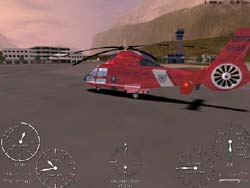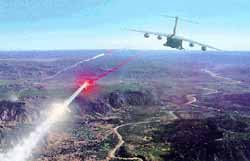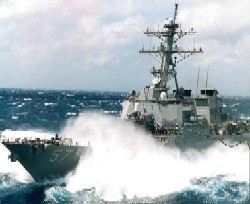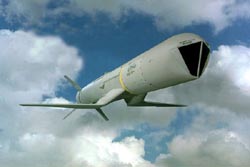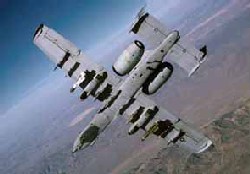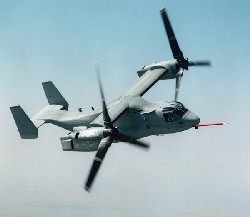Page 1
Daily News
By Gail Helmer
| Send Us News | Archives | Main |
Monday September 16, 2002
PC News
- Search and Rescue Series Continues
- USAF Completes Live-Fire Tests Of LAIRCM System
- Navy Announces DDG Multiyear Contract
- Boeing SLAM-ER Becomes First Missile with OPEVAL
- Litening Extended Range Pod Integrated On A-10
- Air Force CV-22 Resumes Flight Testing
Search and Rescue Series Continues
Global Star Software has revealed plans to release a fourth installment in its Search and Rescue series. Search and Rescue: Coastal Heroes will allow players to fly a trio of different rescue helicopters in a series of rescue missions for the U.S. Coast Guard. Players will be able to assess missions before embarking and choose rescue procedures and techniques tailored to the mission. Search and Rescue: Coastal Heroes is due out later this fall.
Military News
USAF Completes Live-Fire Tests Of LAIRCM System
Northrop Grumman Corporation's Large Aircraft Infrared Countermeasures (LAIRCM) system, chosen by the U.S. Air Force to protect its transport aircraft from the threat of heat-seeking missiles, has successfully completed live missile fire tests and has entered low-rate initial production.
"The LAIRCM system has passed another key milestone on its way to safeguarding the Air Force's fleet of C-17 and C-130 aircraft," said Bob Del Boca, vice president, Infrared Countermeasures and Laser Systems, at Northrop Grumman's Defensive Systems Division. "The fact that the live-fire tests were completed only weeks after laser effectiveness testing is evidence of the determination of the LAIRCM team to offer this invaluable level of protection to Air Force transport flight crews as quickly as possible."
The LAIRCM system is a laser-based, next-generation system employing many of the elements that are common with Northrop Grumman's AN/AAQ-24 (V) NEMESIS system currently in use by the military in both the United States and the United Kingdom. The AN/AAQ-24(V) NEMESIS system protects large fixed-wing transports and small rotary-wing aircraft from the infrared missile threat by automatically detecting a missile launch, determining if it is a threat and activating a high-intensity countermeasure system to track and defeat the threat. The LAIRCM next-generation system introduces new improved capabilities, including an all-band laser subsystem.
During the live fire tests, the LAIRCM system was mounted on a cable car equipped with heat sources representing a C-17 signature, which was used as a target for surface-to-air infrared-guided missiles. Live missiles were then launched against this target from inner-, mid-, and outer-ranges, across the missile's high "probability of kill" envelope. In each of these tests, the LAIRCM system was fully autonomously operated and had no prior knowledge of threat type or location. The system had to detect and declare the threat missile, then allocate the jamming assets required to defeat it.
As a further test, two of the live-fire missions involved multiple missile engagements. During these engagements, the system successfully recognized that it had defeated one threat and then reallocated its resources to defeat the other threat.
Navy Announces DDG Multiyear Contract
The U.S. Navy today awarded Northrop Grumman Corporation a contract valued at $1.9 billion to build four additional DDG 51-class Aegis-guided missile destroyers. The contract, awarded to Northrop Grumman's Ship Systems sector in Pascagoula, includes the immediate award of four ships. The contract is part of a multiyear procurement plan under which the Navy is awarding multiple ships under a single contract.
The announcement brings the total ships awarded in this program to 60. Based on this four-ship award to Northrop Grumman Ship Systems, the company will have received contracts for 28 Aegis destroyers, with 17 of these ships already delivered.
Under this multiyear contract, Northrop Grumman Ship Systems and General Dynamics' Bath Iron Works shipyard will build one more ship each in fiscal years 2002 through 2005. Bath Iron Works will also build an additional option ship in fiscal 2004 and 2005. This arrangement was part of an agreement in June among the Navy and the shipyards that transferred the construction of four LPD 17 amphibious assault ships from Bath Iron Works to Northrop Grumman Ship Systems.
The Navy's Aegis fleet provides primary protection for the Navy's battle forces. Aegis destroyers, designed to match maximum survivability with potent offensive capability, are 509.5 feet long, with a beam of 66.5 feet. Four gas turbine engines power the 9,300-ton ships to speeds in excess of 30 knots. The destroyers' Aegis Combat System is the world's foremost naval weapons system.
Boeing SLAM-ER Becomes First Missile with OPEVAL
The Boeing Standoff Land Attack Missile-Expanded Response, or SLAM-ER, Automatic Target Acquisition capability has become operational with the completion of Operational Test and Evaluation, or OPEVAL.
An independent test team from the U.S. Navy's Air Test and Evaluation Squadron 9 conducted the evaluation at Naval Air Weapons Station China Lake, Calif. The OPEVAL report issued by Commander, Operational Test and Evaluation Force on Sept. 3, 2002, grades the SLAM-ER ATA operationally effective and operationally suitable.
The ATA system adds a second mission computer to the SLAM-ER missile. Algorithms in the computer examine output from the missile's infrared imager for target locations, enabling the ATA system to locate small targets in cluttered environments and either cue the pilot or guide the missile autonomously to the target.
SLAM-ER is the only weapon of its type with an operational ATA capability. In addition to ATA modes of operation, SLAM-ER is capable of flying automatically to its target using GPS-only inputs. It has several different modes for tracking targets using its seeker including being directed to a desired impact point manually by an operator in an aircraft.
SLAM-ER addresses the U.S. Navy's requirements for a precision-guided standoff outside-of-area defense weapon. SLAM-ER extends the weapon system's combat effectiveness, providing an effective, long-range, precision-strike option for both pre-planned and target-of-opportunity attack missions against land and ship targets.
This missile configuration also includes logic to process in-flight target updates for hitting moving ships or relocatable targets. This capability is expected to become operational following a successful test shot later this year.
All SLAM-ER missiles produced and deployed in the fleet today contain the ATA capability. Earlier production missiles are being retrofitted. Boeing is currently under contract with the U.S. Navy to produce 376 SLAM-ERs, with production expected to continue beyond 2004. The inventory objective is currently approximately 700 SLAM-ERs.
Litening Extended Range Pod Integrated On A-10
The LITENING Extended Range (ER) targeting and navigation system produced by Northrop Grumman Corporation's Electronic Systems sector has been successfully integrated and flight tested on another U.S. military platform -- the A-10 Thunderbolt II.
LITENING ER is a self-contained, multisensor laser target designating and navigation system that enables fighter pilots to detect and identify ground targets for highly accurate delivery of both conventional and precision-guided weapons. LITENING ER features include a 640 x 512 pixel Forward-Looking Infrared (FLIR) camera; charge-coupled device television; laser spot tracker/range finder; IR marker; and a laser designator. LITENING ER is currently deployed with the U.S. Marine Corps (USMC) and is entering the fleets of allied and naval forces.
The LITENING ER-equipped A-10 made eight successful flights at Davis-Monthan Air Force Base, Tucson, Ariz., in support of Precision Engagement Risk Reduction Operational Utility Evaluation, in late July. The integration required no changes to the aircraft's existing software. A "smart" cable connecting the pod to the aircraft allowed full functionality with only minor updates to the LITENING software. Following the flights, the LITENING ER-equipped A-10 immediately deployed to Nellis Air Force Base in Las Vegas, Nev., where it employed laser guided weapons and participated in the Joint Experimental Force Experiment.
The successful demonstration makes the A-10 the third U.S. aircraft to be integrated with the LITENING ER pod. Integration on the USMC's AV-8B occurred in August 2001 and the Air Force's F-16 in January of this year.
LITENING ER's predecessor, the LITENING II system with a 256 FLIR, is fully operational with the U.S. Air National Guard/Air Force Reserves Command F-16s, the USMC AV-8Bs, plus the air force of Spain and the Italian Navy. "It is the most capable targeting pod employed during Operations Northern Watch, Southern Watch and Enduring Freedom," added Lennon.
Air Force CV-22 Resumes Flight Testing
The Air Force's CV-22 tiltrotor aircraft resumed flight tests in the skies over Edwards Sept. 11. The aircraft's successful return to flight comes after meeting the recommendations of several independent investigations and military review panels.
All CV-22 flight tests were halted after a December 2000 crash of a Marine MV-22 Osprey grounded the entire V-22 fleet. This resulted in a series of reviews including the Defense Department's blue ribbon panel of defense and industry experts.
Since then, a diverse team of engineers, pilots, maintainers and program officials from Naval Air Systems Command, Air Force Special Operations Command and the V-22 integrated test teams, along with contractors Bell, Boeing and Rolls Royce, have been working together to restructure the V-22 program, bringing it in line with the defense and industry recommendations.
Members of the CV-22 Integrated Test Force have gone above and beyond their typical flight test role in returning the CV-22 to flight, said Maj. Greg Weber, the government's CV-22 flight test director here.
"We have been hands-on in the rigorous design and implementation of the corrections to those deficiencies identified by the review panels -- mainly electrical and hydraulic line clearances and improved maintenance access to the nacelles," said Weber. "Today, the CV-22 complies with every one of the blue ribbon panel recommendations, applying more stringent line clearance requirements across the entire platform." Weber said that not only has test force worked out all mechanical, electrical and software discrepancies but also has a phased delivery plan to return an even safer and more capable aircraft to the fleet.
"The Air Force Flight Test Center wants to restore confidence in the CV-22 and deliver a safe, reliable and operationally suitable aircraft," said Weber.
During the initial flights, the two-pilot test crew conducted several runway landing patterns and put the aircraft into a hover to test its rotor track and balance. Later in the day, the test team returned to the air and successfully converted the aircraft to airplane mode.
These initial test flights are designed to shakedown the aircraft after its long modification period and will continue over the next few weeks, said CV-22 chief test pilot Marty Shubert of Bell Helicopter, who piloted the CV-22 on its return to flight. The flights are also providing pilot recurrency training for the CV-22 test crews, Shubert added.
"All of our initial test flights are part of a methodical and event-driven test flight program to validate engineering and software changes and to further test the capabilities of this aircraft to carry out its intended missions," said Shubert.
The tilt-rotor aircraft fills a long-standing U.S. Special Operations Command and Air Force requirement to conduct long-range insertion and extraction missions in one period of darkness. The CV-22 has twice the altitude and speed, and three-to-five times the range of current aircraft used in special operations.
After the successful flights, the commander of the Air Force Flight Test Center here, Maj. Gen. Doug Pearson, said he was proud of the dedication and hard work demonstrated by the CV-22 Integrated Test Force in returning the aircraft to flight.
"The team used good discipline to make all of the modifications necessary to get the CV-22 back into the air," Pearson said. "I'm looking forward to completing developmental tests on this aircraft and seeing what the CV-22 system has to offer."
Today, there are two CV-22 aircraft at Edwards AFB participating in the engineering and manufacturing development stage of development. Air Force procurement plans call for two additional production representative test vehicles to be delivered in fiscal year 2005 with initial operational test and evaluation to follow at Edwards.
The return to flight and subsequent flight testing will assist senior defense leaders in making a final determination about the system's viability and procurement. (Source:Air Force Flight Test Center Public Affairs)
| Send Us News | Archives | Main |
